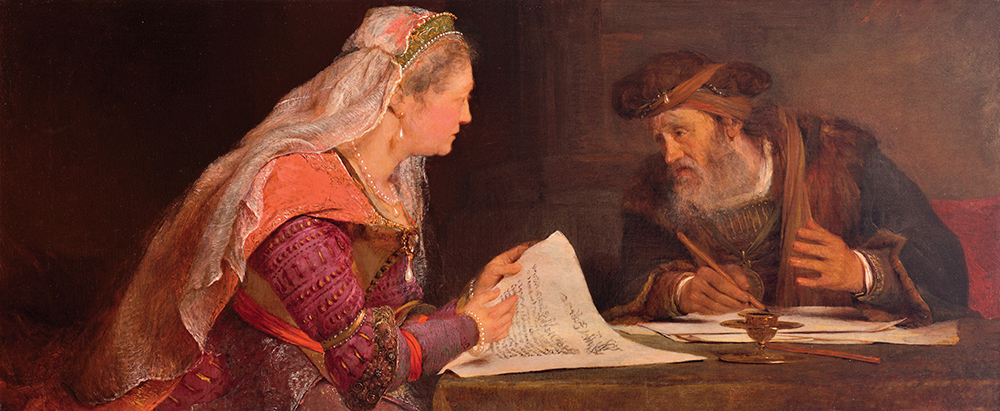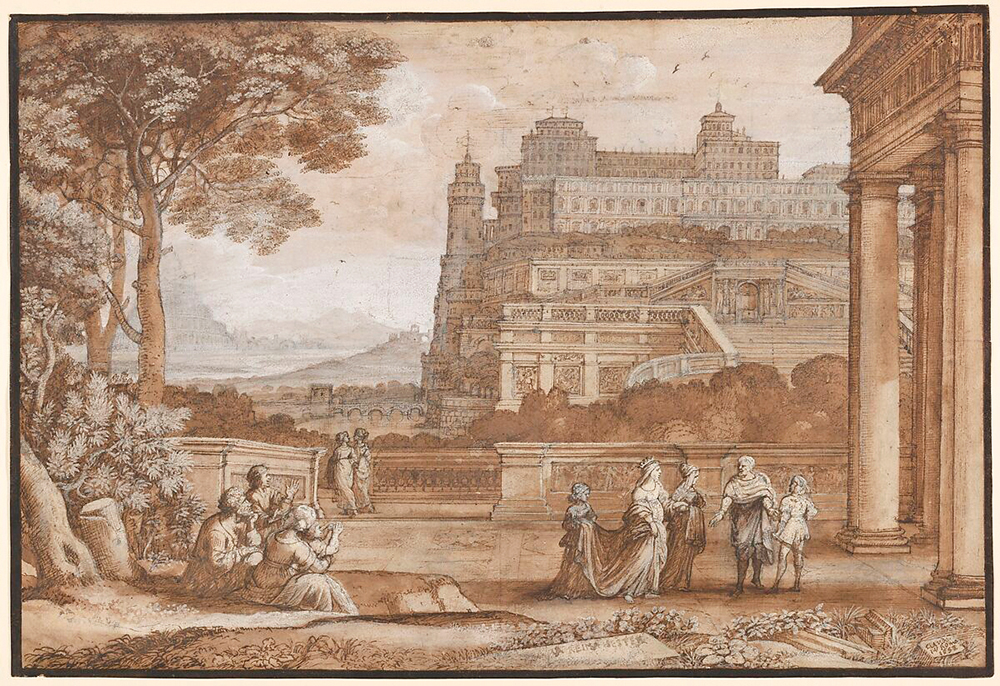
The first time I saw a painting of Queen Esther hanging on the wall of an art museum I was truly surprised. The second time I saw Queen Esther depicted, this time in New York’s Metropolitan Museum of Art, I was intrigued. With Purim approaching, I was curious to better understand Megillat Esther’s appearance in classical art.
In fact there are dozens of Megillat Esther inspired paintings completed over hundreds of years, many now in the finest art museums around the world. Rembrandt van Rijn, the most famous Dutch painter of the Baroque period, painted two scenes from the Megillah and sketched at least one more.
Bible themes run deep through medieval and Baroque periods, a time when the works of Tanach were known to the educated members of society, whether in Hebrew or a Greek or Latin translation. The stories of the Tanach are dramatic and fit well with the European Baroque period that emphasized theatricality, bold colors, light and dark shading and exaggerated poses. Indeed, many of Rembrandt’s works are based on varied Tanach scenes. Numerous early modern period artists and beyond have painted hundreds of biblical scenes.
The Book of Esther specifically, presents a rich tapestry for an artist to paint: a palatial setting, a king, queen and viceroy, palace intrigue and the survival of a people in the balance. In the case of Artemisia Gentileschi, the most famous female Italian painter in the early 1600s, who often featured women of action and resolve, painting Esther was a perfect fit. Gentileschi also painted “Jael and Sisera” as she holds a tent peg against her enemies’ head while her other hand holds a hammer.
I will describe four works that depict different scenes from Megillat Esther.
In the first painting I saw of Esther displayed in a museum she was seated opposite Mordecai, who leans toward her with a quill in his hand. In “Esther and Mordecai,” painted around 1685 by Dutch artist Art de Gelder, Esther holds the corner of the second letter of Purim. It is one of four scenes from Megillat Esther he painted. This one hangs in the Rhode Island School of Design Museum of Art in Providence, Rhode Island.

Esther is seen in profile. The light illuminates our heoine’s face while Mordecai, with a gray beard, brown turban, robe and scarf, looks up toward her. He is in the shadows. They are the sole subjects with a focus on Esther, here depicted with a flowing hair covering, a purple gown and one large glistening pearl that dangles from an earring and a similarly sized pearl that hangs from a necklace. The pearls create two points of light that are impossible to miss.
French painter Claude Lorrain painted “Queen Esther Approaching the Palace of King Ahasuerus” several decades earlier in 1658. He depicts a scene we could imagine. This elaborate drawing in pen and brown ink captures Esther and her entourage as they approach the towering columnar entrance of the palace to our right, with her flowing gown and train, held up by a courtier. Esther knows that an uninvited appearance before the king could lead to her death, and Lorrain creates a sense of the magisterial, trepidation and dread.
While Lorrain’s masterpiece is not currently on display at the Met, “Esther Before Ahaseurus” by Artemisia Gentileschi, painted around 1620, is on view at the museum. It depicts the next scene as Esther finally stands before the king. Painted in a theatrical style, this large oil on canvas shows Esther facing the king. She is positioned on the far left, partially turned toward the viewer and dressed in a flowing gown with a train and sash. She appears to faint, knees bent forward, shoulders falling backward, her gaze averted from the noticeably youthful king who is seated to the far right. The king appears poised to assist his queen but he remains seated, looking down from his modest throne.
The entire center of the painting is noticeably dark and empty, which contrasts with the king’s purple shawl on the right and Esther’s turquoise sash on the left. Gentileschi’s depiction of Esther fainting before the king is a detail not described in the Megillah but rather in the Greek version, which was perhaps the source of her inspiration. Nonetheless, the artist clearly knew that Esther, like the other heroines she painted, ultimately prevailed.

Rembrandt van Rijn painted “Ahasuerus, Haman and Esther” around 1660, and it depicts three people at the center of Megillat Esther seated at a modest table. Rembrandt brings us to the moment after Esther told the king of Haman’s plot to kill the Jews. Esther, seated on the right, is bathed in light. Her crown, raspberry pink gown and flowing bejeweled train, which extends to the edge of the painting, are all illuminated. The king in his royal robe and crown sits in the center and Haman, on the left, head bowed, almost disappears into the dark shadows. Now, Rembrandt shows us, it is Haman’s turn for trepidation. Only an apple, a symbol of sin, and some grapes, symbols of hope and redemption in some traditions, appear on the table, a detail that does not appear in the Megillah. This painting reportedly was once owned by Catherine the Great and now hangs in the Pushkin Museum in Moscow.
That the story of Esther and Purim are beloved by Jews across the generations is not surprising. The holiday is a needed reminder of the themes of self-sacrifice, hope, redemption and victory, even against overwhelming adversity. That this same story has captured the imagination of the best artists over centuries is another reminder that the story of Esther speaks to people on many different levels and that the hopeful themes of Megillat Esther are universal and timeless.
Howard E. Friedman is an occasional writer and lives in Teaneck.









